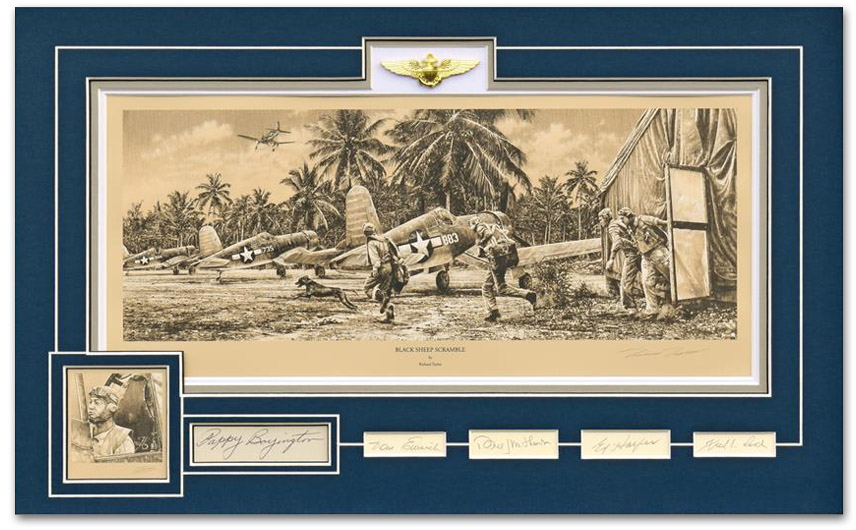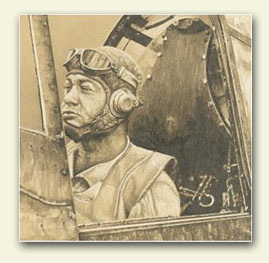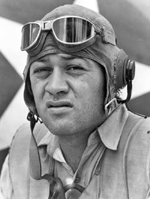

Black Sheep Scramble
by Richard Taylor
Under the guidance of their mercurial leader Major Gregory 'Pappy' Boyington USMC, the F4U pilots of VMF-221 'The Black Sheep' scramble from their base in the Solomon Islands to intercept an incoming Japanese raid, late 1943. September 1943, and the tide of war in the Pacific had turned against the Japanese. Halted and repulsed at Midway and Guadalcanal, their lines of supply had become thinly stretched as the overwhelming might of the American war machine began to tell. But the fighting was far from over as the Japanese fought bitterly for every yard conceded; savage encounters that continued for two more years. Onto this stage stepped the unconventional figure of U.S. Marine Major Gregory 'Pappy' Boyington, a former 'Flying Tiger' pilot with several victories to his credit. His task: to re-form VMF-214. Allocated an equally unconventional rag-tag bunch of pilots, some battle-hardened, disbanded veterans heading for the pilot pool, others merely fresh-faced, untested rookies. Boyington was given less than four weeks to get his unit into shape and combat ready. Not only did he succeed but in the space of less than three months he and his F4U Corsair pilots would acquire legendary status - they called themselves the 'Black Sheep'. Usually outnumbered, always aggressive and never timid, the 'Black Sheep' quickly notched up nearly one hundred air victories along with numerous aircraft damaged in the air or on the ground, several warships, countless vehicles, buildings, and a myriad of other military targets. On 3 January 1944, however, whilst leading an early morning sweep over Rabaul, Boyington's luck ran out. Heavily outnumbered by enemy fighters, in the ensuing mêlée he was shot down only to be picked up by a Japanese submarine and taken prisoner for the rest of the war. With claims of twenty-eight air victories, he was already, and would remain, the highest-scoring Marine pilot of the war. For this, and his period commanding the 'Black Sheep', he was granted America's highest award - the Medal of Honor - his citation commending how he 'struck at the enemy with daring and courageous persistence' which resulted in 'inflicting crippling damage on the enemy'. 'Pappy' also received the Navy Cross, the United States Naval Service's second-highest military decoration after the MoH, and is considered one of the Marine Corps' greatest ever pilots. In a tribute to one of America's legendary wartime Aces, Richard Taylor has produced yet another inspirational drawing to add to his growing list of masterworks. There is no doubt that this extremely limited edition will be popular with collectors interested in the War in the Pacific, especially given the inclusion of such rare and sought after original signatures. These consist of the famous Ace depicted, 'Pappy' Boyington, and four F4U pilots of VMF-221, all of whom scored confirmed combat victories. |
| Overall size: 14¾" x 23¾" | SOLD OUT | Image size: 6½" x 17¼" |
| 11 | Veteran's edition | Signed by artist, matted with the signature of 'Pappy' Boyington and four VMF-221 pilots |
 |
Personally signed by the artist and hand numbered, Richard's piece has been faithfully reproduced as high-quality giclée fine art prints on archival paper. Alongside is a completely separate portrait of ‘Pappy’ Boyington, museum-quality reproduction U.S. Naval Aviator Wings and a total FIVE veteran autographs Colonel Gregory 'Pappy' Boyington MoH Brigadier General Bruce J. Matheson Colonel Edwin A. Harper Lieutenant Colonel W. Thomas Emrich Captain Fred S. Losch |
| The Signatures |
Boyington began his military training in college as a member of Army ROTC and became a cadet captain. In the spring of 1935, he applied for flight training under the Aviation Cadet Act, but he discovered that it excluded married men. Boyington had grown up as Gregory Hallenbeck, and assumed his stepfather, Ellsworth J. Hallenbeck, was his father. When he obtained a copy of his birth certificate, he learned that his father was actually Charles Boyington, and that his parents had divorced when he was an infant. As there was no record of any Gregory Boyington had ever been married, he enrolled as a U.S. Marine Corps aviation cadet using that name. In February 1936 Boyington was assigned to Naval Air Station, Pensacola, Florida, for flight training. He was designated a Naval Aviator on March 11, 1937, then transferred to Quantico, Virginia, for duty with Aircraft One, Fleet Marine Force. He was discharged from the Marine Corps Reserve on July 1, 1937, in order to accept a second lieutenant's commission in the regular Marine Corps the following day. Boyington resigned his commission in the Marine Corps on August 26, 1941, to accept a position
with the Central Aircraft Manufacturing Company (CAMCO). CAMCO was a civilian firm that
contracted to staff a Special Air Unit to defend China and the Burma Road. This later became
known as the American Volunteer Group, the famed Flying Tigers. During his
time with the Tigers, Boyington became a flight leader. He was frequently in trouble with the
commander of the outfit, Claire Chennault. Boyington was officially credited with 2 Japanese
aircraft destroyed in the air and 1.5 on the ground, but AVG records suggest that he may have
been owed an additional ground "kill". In April 1942, he broke his contract with the AVG and
returned to the United States. In September 1943, he became commanding officer of Marine Fighter Squadron 214, better
known by its nickname, the "Black Sheep Squadron." Boyington received the nickname "Gramps", because at age 31, he was a decade older than most
of the Marines serving under him. The name "Gramps" was later changed to "Pappy". |
| Brig. Gen. Bruce Matheson USMC Born in Chicago in 1921, Bruce Matheson enlisted in the Marine Corps in 1942 and joined the ‘Black Sheep’ on 7th. August 1943. On 17th. October 1943 he shot down a Zero over Kahili but was wounded during the aerial combat. He safely landed his badly damaged Corsair at Munda. On 3rd. January 1944 Bruce scored his last aerial victory, he also confirmed Major Boyington’s final aerial victory before ‘Pappy’ was shot down near Rabaul. By the end of the second ‘Black Sheep’ tour Bruce would have three confirmed victories and one and a half probables. For his third combat tour he was transferred along with 14 other ‘Black Sheep’ pilots to VMF-211 on Green Island. |
| Lt. Col. W. Thomas Emrich USMC Thomas Emrich joined VMF-214 on 7th. August 1943, flying two combat tours with them. On 15th. October he shot down two Zeros in aerial combat over Kahili, but the next day, on a fighter sweep, had to ditch off Vella Lavella and be rescued by a PT boat. He flew 68 missions with the ‘Black Sheep’, then a third tour with VMF-211 with other former ‘Black Sheep’ pilots. |
| Capt. Fred S. Losch USMC Hailing from Pennsylvania, Fred Losch joined the ‘Black Sheep’ as a replacement pilot on 10th. Nov. 1943. On 2nd. Jan. 1944 he downed a Zero and damaged another over Rabaul. With VMF-214 he flew 28 combat missions, completing a second tour with VMF-211. |
| Col. Edwin A. Harper USMC Born in Canada, Ed Harper joined VMF-214 on 7th August 1943 and flew two tours until January 1944, scoring a victory and two probables on sweeps over Kahili and Rabaul. Wounded on 17th October, the next day he flew a mission and scored a probable. Ed was reassigned to VMF-211 for a third tour after VMF-214 were disbanded in January 1944. |
| Receive your print fully framed and ready to display. Please call or email us for a custom framing quote. |
 Col.
Col.